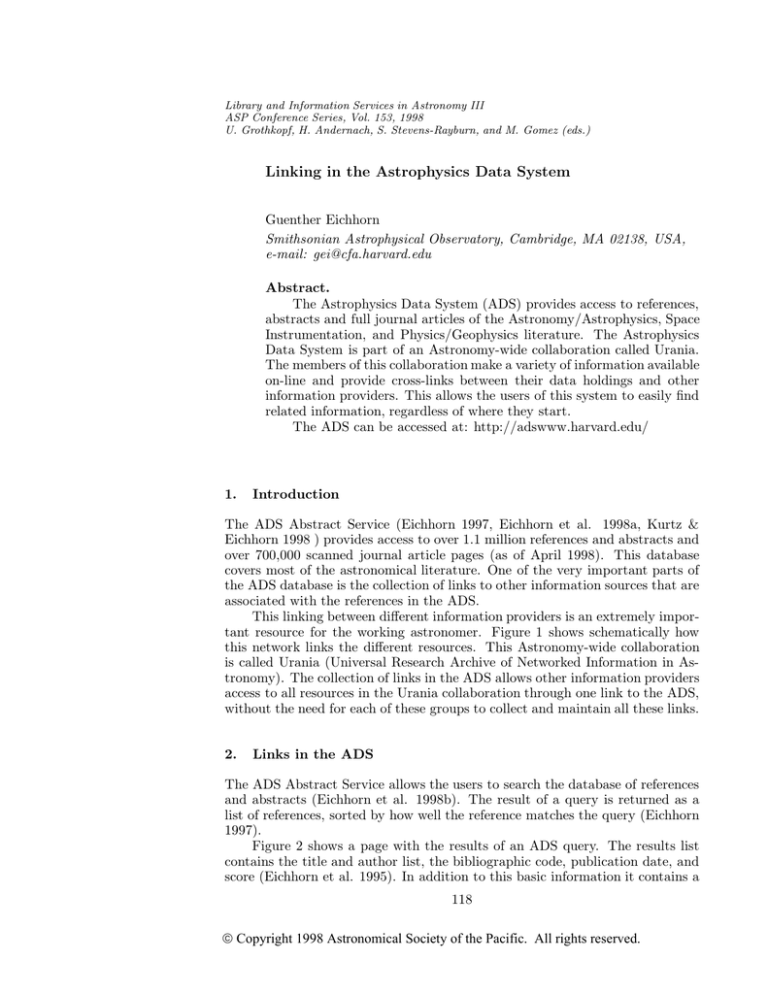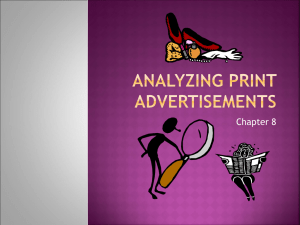
Library and Information Services in Astronomy III
ASP Conference Series, Vol. 153, 1998
U. Grothkopf, H. Andernach, S. Stevens-Rayburn, and M. Gomez (eds.)
Linking in the Astrophysics Data System
Guenther Eichhorn
Smithsonian Astrophysical Observatory, Cambridge, MA 02138, USA,
e-mail: gei@cfa.harvard.edu
Abstract.
The Astrophysics Data System (ADS) provides access to references,
abstracts and full journal articles of the Astronomy/Astrophysics, Space
Instrumentation, and Physics/Geophysics literature. The Astrophysics
Data System is part of an Astronomy-wide collaboration called Urania.
The members of this collaboration make a variety of information available
on-line and provide cross-links between their data holdings and other
information providers. This allows the users of this system to easily find
related information, regardless of where they start.
The ADS can be accessed at: http://adswww.harvard.edu/
1.
Introduction
The ADS Abstract Service (Eichhorn 1997, Eichhorn et al. 1998a, Kurtz &
Eichhorn 1998 ) provides access to over 1.1 million references and abstracts and
over 700,000 scanned journal article pages (as of April 1998). This database
covers most of the astronomical literature. One of the very important parts of
the ADS database is the collection of links to other information sources that are
associated with the references in the ADS.
This linking between different information providers is an extremely important resource for the working astronomer. Figure 1 shows schematically how
this network links the different resources. This Astronomy-wide collaboration
is called Urania (Universal Research Archive of Networked Information in Astronomy). The collection of links in the ADS allows other information providers
access to all resources in the Urania collaboration through one link to the ADS,
without the need for each of these groups to collect and maintain all these links.
2.
Links in the ADS
The ADS Abstract Service allows the users to search the database of references
and abstracts (Eichhorn et al. 1998b). The result of a query is returned as a
list of references, sorted by how well the reference matches the query (Eichhorn
1997).
Figure 2 shows a page with the results of an ADS query. The results list
contains the title and author list, the bibliographic code, publication date, and
score (Eichhorn et al. 1995). In addition to this basic information it contains a
118
Copyright 1998 Astronomical Society of the Pacific. All rights reserved.
Linking in the Astrophysics Data System
Library
Query
Object
Query
Latest
Literature
Article
Archive
ADS
Abstracts
Natural
Language
Query
Data
Center
Object
Database
Electronic
Journal
Coordinate
Query
Object
Query
Latest
Literature
119
Figure 1.
Connectivity Network in the Astronomical Digital Library
collaboration called Urania
list of links with each reference, anchored to individual letters. Table 1 shows
the list of different links available, together with the number of times each link
is contained in the database.
The ‘O’ and ‘A’ links point to different versions of the abstract for the
reference. The ‘A’ link points to abstracts that were re-written by the Scientific
and Technical Information project (STI) at NASA. The ‘O’ link points to the
original author abstract. We get these author abstracts either directly from the
journal, from conference proceedings editors, or from the authors themselves.
The ‘E’, ‘F’, and ‘G’ links point to different versions of the full article. The
‘E’ links point to on-line HTML versions that make use of the World Wide Web
(WWW) technology with links, animations, tables, etc. The access to these
links is generally restricted to subscribers of the journals. The ‘F’ links point
to articles in image format. These can be either Postscript or PDF versions, or
both. These versions also may be restricted to subscribers. The ‘G’ links point
to articles that were scanned in the ADS project (Eichhorn 1997). Access to
these articles is available without restriction world-wide.
The ‘D’, ‘P’, ‘S’, and ‘N’ links point to different data sets associated with
the article. The ‘S’ and ‘N’ links point to lists of astronomical objects mentioned
in the article. They are maintained by the SIMBAD project at the Centre de
Données astronomiques de Strasbourg (CDS), France and the NASA Extragalactic Database (NED) project at the Jet Propulsion Laboratory (JPL) in
120
G. Eichhorn
Figure 2.
Results list from ADS abstract query
Pasadena, CA, USA respectively. The ‘D’ and ‘P’ links point to on-line data
sets associated with the reference (the ‘P’ links point to the Planetary Data
System (PDS), the ‘D’ links point to several different data centers).
‘R’ and ‘C’ links point to the list of references in the article and the list of
publications that cite the article, respectively.
‘M’ links point to on-line document delivery systems that allow the user
to order copies of individual articles. ‘L’ links point to entries for books in the
Library of Congress’ on-line library. ‘T’ links provide access to the table of
contents for conference proceedings volumes.
The bibliographic codes mentioned above are a vital part of the Astronomy
Digital Library and the Urania collaboration. They allow different information
Linking in the Astrophysics Data System
Link
A
C
D
E
F
G
I
L
M
N
O
P
R
S
T
Table 1.
Description
NASA/STI abstract
Citations for article
Data available
Electronic on-line article
Full text of article
Scanned journal articles
Author information
Library catalog entry
Mail ordering of articles
NED objects
Original author abstract
PDS on-line data
References in article
SIMBAD objects
Table of contents
121
Number
170,00
71,000
4,700
25,000
14,000
77,000
100
18,000
3,000
27,000
49,000
5
79,000
98,000
1,000
Links types and their numbers in the ADS database
Reference:
Rester, A.C., et. al., 1 9 8 9 , ApJ. 3 4 2 , L 9 1
Bibcode:
1989ApJ...342L..91R
Figure 3.
Composition of Bibliographic Codes
providers to link to individual articles without having to coordinate the link
information for each article. These codes can be calculated automatically from
a regular journal reference and can be easily understood by the user. They are
by now used by most information providers in Astronomy. Figure 3 shows how
these codes are constructed. A more detailed description is available on-line at:
http://adsdoc.harvard.edu/abs doc/bibcodes help.html
A list of journal abbreviations used in these codes is available at:
http://adsdoc.harvard.edu/abs doc/journal abbr.html
These bibliographic codes (or bibcodes for short) provide the glue for the
linking between the different partners in the Urania collaboration. Most systems
provide so-called “name resolvers”. These name resolvers accept a request with
G. Eichhorn
122
a bibcode as identifier and forward the request to the internal address where the
data items for that reference are stored. This system makes it very easy for one
data system to link to another without having to coordinate link information
for each reference. Every data provider can calculate the necessary bibcodes
without consulting other servers. The ADS provides a bibcode verification utility
that allows the system that generates the bibcode to check whether the code is
available in the ADS.
Number
Number
Number
Number
of
of
of
of
Abstract Service Users
Queries
References retrieved
Abstracts retrieved
Percentage of
Percentage of
Percentage of
Percentage of
Percentage of
Author Queries
Text Queries
Title Queries
Object Queries
Multiple Field Queries
Number of Article Service Users
Number of Queries
Number of Pages retrieved
Table 2.
65%
30%
25%
5%
18%
8,000
150,000
380,000
Monthly usage statistics of the ADS database for March, 1998
Link code
A,O
G
F
E
C
S,N
R
D,P
M
L
T
I
Table 3.
17,000
370,000
6,100,000
300,000
Link type
Abstracts
Scanned Articles
Full Text Articles
Electronic Articles
Citations
Object Lists
References
Data
Mail Order
Library Entries
Table of Contents
Author information
Usage
300,427
34,362
12,557
9,100
4,121
2,593
2,336
830
183
133
63
13
Monthly usage of links in the ADS database for March, 1998
Linking in the Astrophysics Data System
3.
123
Linking of Mirror Sites
The ADS as well as many other information providers have multiple sites with
the same information to improve access for users in different parts of the world.
The ADS currently has mirror sites at the CDS in Strasbourg, France and at
NAO in Tokyo, Japan. We are in the process of setting up a third mirror in
Chile. Other information providers also maintain multiple mirror sites. This
has two different implications for the ADS.
The first one is to synchronize our data and software at our mirror sites
to always provide the same information. The second is to manage our links so
they can point to different mirror sites of our data and the data of other data
centers.
We have solved the first issue by developing automated procedures that
synchronize the data and software on our mirror sites. The mirroring operation
is started from a password protected web form. The data manager selects which
part of the system needs to be mirrored and to which mirror site it needs to be
transferred; the rest is done automatically through the mirroring scripts. The
mirroring scripts use the same configuration files as the server software and can
therefore run on any of our sites without modification (just as the server software
which is configured entirely through these configuration files).
The second issue cannot be resolved by the ADS alone, since the decision as
to which mirror site of a particular data source to use depends on the connectivity between the user and the different mirror sites of the data source. The mirror
selection therefore has to be done by the user. We provide a choice of mirror
sites in our preference settings form. The user can select any of the mirror sites
available. This selection is then used whenever a link to this data source is built
by the ADS software. All choices for the different mirror sites of the various
information providers are defined in a configuration file. This configuration file
is distinct for each ADS mirror site, so that the defaults for each data source are
set appropriately for each of our mirrors. This provides a very flexible scheme
for handling links to various mirrors of our collaborating data centers.
4.
Access Statistics
The ADS services are accessed by astronomers world-wide. Table 2 lists some
access statistics for March, 1998. The number of users of the Abstract Service
per month is 17,000. This is about the number of astronomers world-wide. This
means that most working astronomers are using this service at least once per
month. The number of references retrieved per month of 6.1 million means that
each reference on average is retrieved almost six times per month.
The usage of the different query fields (see table 2) shows that the majority
of queries ask for articles based on author names (65%). Text queries are next
most frequent with 30%, followed by title queries with 25%. Object queries are
used in 5% of the queries. Queries with search criteria in multiple fields make up
less than 20% of the queries. This statistic clearly shows that having references
without abstracts in the database is still a very valuable resource, since they can
be found in 90% of the queries that our users issue.
G. Eichhorn
124
Field
Usage
Statistics
100
Percent of Queries
90
Author Queries
Object Queries
Title Queries
Text Queries
80
70
60
50
40
30
20
10
0
1
2
3
4
5
Number of Search Words
Figure 4.
Usage of the different query fields in the ADS abstract service
The query fields fall into two categories as far as the number of search words
is concerned. Author queries and object queries are used overwhelmingly with
only one search term (author name or object name respectively). Searches with
two authors make up about 15% of the author queries, searches with two objects
only about 5% of the object queries. On the other hand, title and text searches
are done frequently with more than one word. Title and text searches with one
or two words make up about 30% each of these queries, searches with three
words make up about 20% each.
Kurtz & Eichhorn 1998 show some more detailed access statistics for the
Astronomical Journal for articles published between 1944 and 1997.
Table 3 shows how often each of the types of links was used in March, 1998.
Most frequently used, of course, are the abstracts. The next most frequently used
link type, as expected, are the full articles. Between on-line HTML articles,
article images on other sites and scanned articles on the ADS server, 55,000
articles were called up in March, 1998. This amounts to over 2,500 articles per
working day on average! The references and citations are called up over 2,000
and 4,000 times respectively. This too is a frequently used information source.
The data links are used less frequently as expected. This does not mean that
these links are not important. The capability to directly access data from a
reference is an important part of the overall system.
Linking in the Astrophysics Data System
5.
125
Summary
Linking to different on-line resources has become a vital part of most on-line
information providers’ tools. The ADS has become a critical part of this system
of links by collecting and managing links to all information providers in the
field of Astronomy. This allows other data centers to access this system of links
through one link to the ADS. This frees the data centers from the need to find
and maintain links to other resources that their users may need. The users are
the ultimate beneficiaries of this system of interlinked astronomical resources.
They can easily access different information providers without having to do
separate searches at the individual centers. The acceptance of this system has
been overwhelming as the usage statistics of the ADS show.
Acknowledgments. This work was funded by NASA under grant NCCW
00254.
References
Eichhorn, G., Accomazzi, A., Grant, C. S., Kurtz, M. J. 1998, The Astrophysics
Data System, these proceedings, 277
Eichhorn, G., Accomazzi, A., Grant, C. S., Kurtz, M. J., & Murray, S. S. 1998,
New Capabilities of the ADS Abstract and Article Service, in Astronomical Data Analysis Software and Systems VII, ASP Conference Series, Vol.
145, R. Albrecht, R.N. Hook and H.A. Bushouse, eds., 378
Eichhorn, G. 1997, The Digital Library of the Astrophysics Data System,
Ap&SS, 247, 189
Eichhorn, G., Accomazzi, A., Grant, C. S., Kurtz, M. J., & Murray, S. S. 1995,
Access to the Astrophysics Science Information and Abstract System,
Vistas in Astronomy, 39, 217
Kurtz, M. J. & Eichhorn, G. 1998, The Historical Literature of Astronomy, via
ADS, these proceedings, 293






